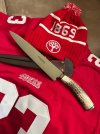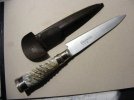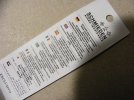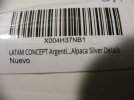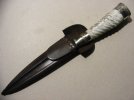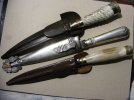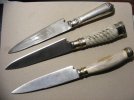-
The BladeForums.com 2024 Traditional Knife is available! Price is $250 ea (shipped within CONUS).
Order here: https://www.bladeforums.com/help/2024-traditional/
You are using an out of date browser. It may not display this or other websites correctly.
You should upgrade or use an alternative browser.
You should upgrade or use an alternative browser.
Gaucho knives and cuchillos criollos of South America
- Thread starter CelloDan
- Start date
Trubetzkoy
Basic Member
- Joined
- Jun 3, 2022
- Messages
- 424
Gauchos needed to slice meat every once in a while, too!Nice! But rather than a Gaucho blade - it looks like a meat slicing blade that would normally be paired with a fork similarly bolstered and handled.
In all seriousness, in Argentina --as I've learned -- these are typically referred to as cuchillos de campo ('field/countryside knives,' in a broader sense than Domenech's use of the term), and they are considered to fall uncontroversially under the cuchillo criollo category (which is the category denoted by the English term gaucho knife) as long as they were meant for the local market. In fact, this type of knife is probably more representative of what the average gaucho would've carried and used back in the day than the fancier silver- or even nickel-silver-mounted pieces we're most used to seeing in this context.
Now, if we adopt Domenech's terminology, this would fall rather straightforwardly under the puñal criollo category, given the almost 9" spear(ish)-point blade, the integral bolster, and the hidden, rat-tail tang.
Perhaps it did originally come with a matching fork, though I've never seen one marked with this importer's stamp -- only knives, typically of the butchering type (i.e., cuchillas in the Argentinean sense).
Trubetzkoy
Basic Member
- Joined
- Jun 3, 2022
- Messages
- 424
Habēmus facōnem:




Trubetzkoy
Basic Member
- Joined
- Jun 3, 2022
- Messages
- 424
Nice memory! It's the same project, but a different blade. The blade I was originally going to use was one with the same dimensions but with the fork or "candelabra" logo, which I quite like. However, once I got hold of this platería I decided I needed the more traditional three-line stamp with the Pikas logo, which is on most Herder gaucho knife blades. I was able to get this particular blade from a US militaria dealer who procured a bunch of NOS Herder blades from a closed factory in Solingen, including a very handsome etched Hirschfänger model, which I think I also showed here but I ended up not buying.Is that your bare Herder blade, now mounted? If so, please share the story of how it all came together.
The handle and scabbard came, as I mentioned a while ago, from a ca. 50s German dagger for the American market, marked "York Cutlery Co.," which I show again below. However, this pattern was made by Linder (who specialized in ornamental metalwork back in the day but at some point began putting together their own knives) and was commonly paired with blades for the South American market, by makers such as Herder and Kirschbaum. As I also mentioned then, I suspect they are pre-WW2 leftovers that were repurposed at a Solingen factory for the newly reopened American market once the war ended.

The blade was a bit too thin for both the handle and the scabbard, and the tang was virtually nonexistent. I found out about this using a magnet and confirmed it when I applied heat to the handle to remove the blade, which turned out to have been attached with a combination of sand and solder:

The reason I took so long to complete this project is that I wanted a more period-correct, nickel silver guard instead of the brass one that came with the York dagger, which was probably made later than the handle and scabbard. When I went to Germany this summer I found a later Linder Kris dagger that had exactly what I needed, in a pattern that was used back in the day for various daggers, including facones. I actually got that knife to modify it for a friend who loves Kris daggers but wanted a different type of hilt -- two birds with one stone. So, this facón is perhaps the most historically correct Frankenstein piece ever put together. I even took the trouble to cut a piece of red wool felt to use it as a washer on top of the guard, as Herder used to do with their fancier daggers, to minimize metal-to-metal contact when the knife is in its scabbard.
By the way, peening the tang of this blade is one of the most difficult things I've done in my knife-fiddler career. Thing was hard -- a testament to the quality of old Herder blades, I suppose. Couple more pictures below:


Trubetzkoy
Basic Member
- Joined
- Jun 3, 2022
- Messages
- 424
Hahaha it's crazy how similar it is to Böker's logo. Superb match -- better than a boina.Still no boina for me, but I ask if you gauchos would find this knit cap acceptable. I saw this and had to have it. Matches both my Arbolito puñal and my Niners jersey.
View attachment 2970494
Here's another goody from my last trip to Europe:

Unusual material choice (nickel-plated brass, except for the throat, which isn't plated) and blade format (with ricasso). Generous blade for a verijero, too (7" long and 5mm thick):

kamagong
Gold Member
- Joined
- Jan 13, 2001
- Messages
- 10,966
The blade was a bit too thin for both the handle and the scabbard, and the tang was virtually nonexistent. I found out about this using a magnet and confirmed it when I applied heat to the handle to remove the blade, which turned out to have been attached with a combination of sand and solder:

The reason I took so long to complete this project is that I wanted a more period-correct, nickel silver guard instead of the brass one that came with the York dagger, which was probably made later than the handle and scabbard. When I went to Germany this summer I found a later Linder Kris dagger that had exactly what I needed, in a pattern that was used back in the day for various daggers, including facones. I actually got that knife to modify it for a friend who loves Kris daggers but wanted a different type of hilt -- two birds with one stone. So, this facón is perhaps the most historically correct Frankenstein piece ever put together. I even took the trouble to cut a piece of red wool felt to use it as a washer on top of the guard, as Herder used to do with their fancier daggers, to minimize metal-to-metal contact when the knife is in its scabbard.
By the way, peening the tang of this blade is one of the most difficult things I've done in my knife-fiddler career. Thing was hard -- a testament to the quality of old Herder blades, I suppose. Couple more pictures below:
Very nice work. The tang is much too nonexistent for my taste, although of course that has nothing to do with you. It reminds me of a video I once watched on Yemeni jambiya. The blades had tangs just as small, and I remembered thinking how weak the construction was for a weapon, especially given the high price tags they sold for.
Hahaha it's crazy how similar it is to Böker's logo. Superb match -- better than a boina.
Here's another goody from my last trip to Europe:

Unusual material choice (nickel-plated brass, except for the throat, which isn't plated) and blade format (with ricasso). Generous blade for a verijero, too (7" long and 5mm thick):

That's because it is Boker's logo. The 1869 refers to the year of the company's founding.
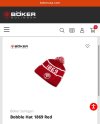
Another enviable piece.
Trubetzkoy
Basic Member
- Joined
- Jun 3, 2022
- Messages
- 424
That picture shows the original blade after I removed it from the handle, not the Herder blade with which I replaced it. The latter has a full-length tang, which I peened:Very nice work. The tang is much too nonexistent for my taste, although of course that has nothing to do with you.

Man! I thought it was some other logo and the similarity was pure coincidence. Hence my emoji reaction to your post, haha. Anyways, still better than a boina, as far as I'm concerned!That's because it is Boker's logo. The 1869 refers to the year of the company's founding.
Probably I wouldn't want to use this knife for cutting endeavors, due to the usual limitations of cylindrical handles. Surprisingly, however, it feels better than my Scholberg, since with this one you can rest your index on the ricasso to keep edge alignment.Another enviable piece.How do you like the cylindrical handle?
screened porch
Basic Member
- Joined
- Feb 19, 2012
- Messages
- 19,335
Reminds me of those Mexican knives I can't remember the name of. I'll have to go downstairs and look it up in my Southwestern Colonial Ironwork.blade format (with ricasso).
[Belduque! (It just came to me.)]
Trubetzkoy
Basic Member
- Joined
- Jun 3, 2022
- Messages
- 424
Another Eberle, with chromed handle and scabbard, Art Deco style:


screened porch
Basic Member
- Joined
- Feb 19, 2012
- Messages
- 19,335
I love that deco Eberle.
I have one coming, stamped Schmieden, which name I'm sure I've seen on Chinese kitchen knife sets, so it's probably Chinese. But it looks well made, and it isn't etched "Dagger" like most of the gaucho knives on the river. The river says this is their last one, and the Argentinian store selling it seems to be out of all their knives on their own website. And with the refund on a recent pair of pants, the knife cost me $42. And with Argentina's financial woes, and with huge tariffs again being threatened for China, and my bank account looking a little bigger than I thought, I bought it.
I have one coming, stamped Schmieden, which name I'm sure I've seen on Chinese kitchen knife sets, so it's probably Chinese. But it looks well made, and it isn't etched "Dagger" like most of the gaucho knives on the river. The river says this is their last one, and the Argentinian store selling it seems to be out of all their knives on their own website. And with the refund on a recent pair of pants, the knife cost me $42. And with Argentina's financial woes, and with huge tariffs again being threatened for China, and my bank account looking a little bigger than I thought, I bought it.
Schmieden is a German word that means "forged".I love that deco Eberle.
I have one coming, stamped Schmieden, which name I'm sure I've seen on Chinese kitchen knife sets, so it's probably Chinese. But it looks well made, and it isn't etched "Dagger" like most of the gaucho knives on the river. The river says this is their last one, and the Argentinian store selling it seems to be out of all their knives on their own website. And with the refund on a recent pair of pants, the knife cost me $42. And with Argentina's financial woes, and with huge tariffs again being threatened for China, and my bank account looking a little bigger than I thought, I bought it.
Trubetzkoy
Basic Member
- Joined
- Jun 3, 2022
- Messages
- 424
I definitely paid more than I should've for that Eberle, but at this point whenever I see an Eberle in a rare pattern and it's not an arm and a leg to get it, I go for it.I love that deco Eberle.
I have one coming, stamped Schmieden, which name I'm sure I've seen on Chinese kitchen knife sets, so it's probably Chinese. But it looks well made, and it isn't etched "Dagger" like most of the gaucho knives on the river. The river says this is their last one, and the Argentinian store selling it seems to be out of all their knives on their own website. And with the refund on a recent pair of pants, the knife cost me $42. And with Argentina's financial woes, and with huge tariffs again being threatened for China, and my bank account looking a little bigger than I thought, I bought it.
Looking forward to seeing that Schmieden. I've seen some very pretty ones online.
Last edited:
screened porch
Basic Member
- Joined
- Feb 19, 2012
- Messages
- 19,335
It should be here tomorrow.  because it really was their last one.
because it really was their last one.
screened porch
Basic Member
- Joined
- Feb 19, 2012
- Messages
- 19,335
screened porch
Basic Member
- Joined
- Feb 19, 2012
- Messages
- 19,335
Trubetzkoy
Basic Member
- Joined
- Jun 3, 2022
- Messages
- 424
Nice,
 screened porch
! What's the handle made of? Looks like fluted antler, which I had never seen but looks cool.
screened porch
! What's the handle made of? Looks like fluted antler, which I had never seen but looks cool.
screened porch
Basic Member
- Joined
- Feb 19, 2012
- Messages
- 19,335
Thanks! Yes, it's antler. They call it sculpted. It feels good, too. It isn't going to slip or bite.Nice,screened porch ! What's the handle made of? Looks like fluted antler, which I had never seen but looks cool.
The edge could use a little finer grit, and maybe a little convexing.
Last edited:
screened porch
Basic Member
- Joined
- Feb 19, 2012
- Messages
- 19,335
It has always bugged me that the Who-ca's blade is backwards in its sheath from all my others.
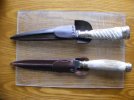
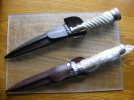
I made up a yarn to explain it, but I think the people who packed the knife just made a mistake. So, finally, duh- wet-forming is so quick and easy, why not just fix it?
Good thing I have others to play with while I endure the agony of waiting for it to dry.


I made up a yarn to explain it, but I think the people who packed the knife just made a mistake. So, finally, duh- wet-forming is so quick and easy, why not just fix it?
Good thing I have others to play with while I endure the agony of waiting for it to dry.
Last edited:

